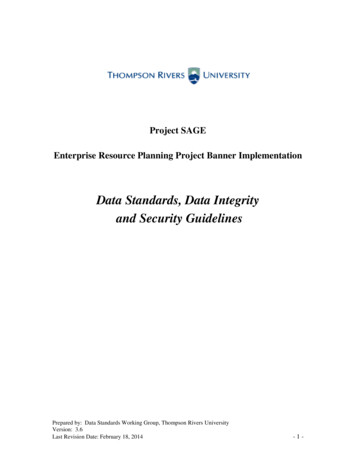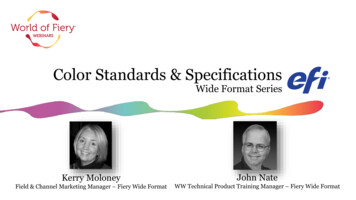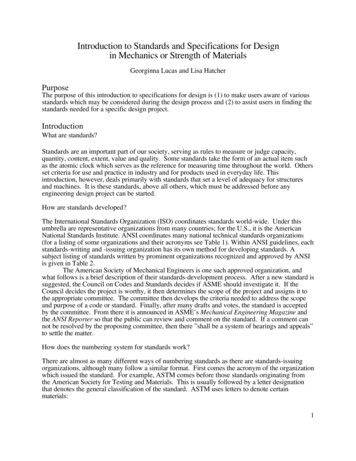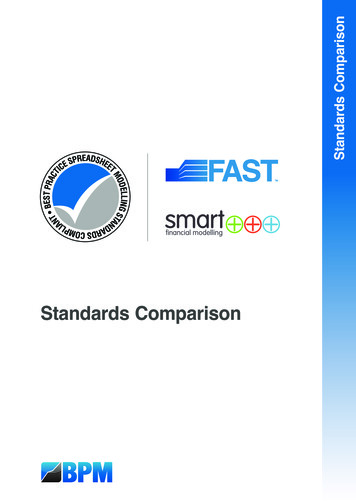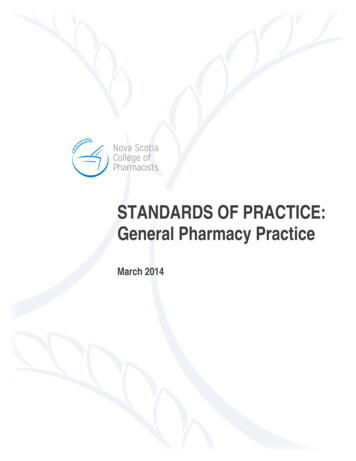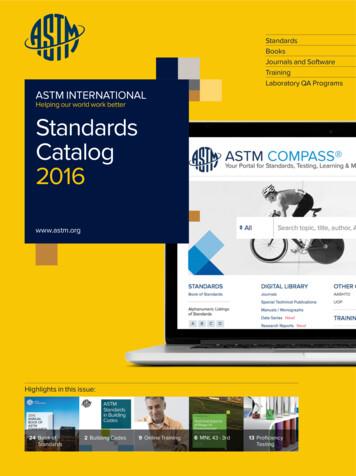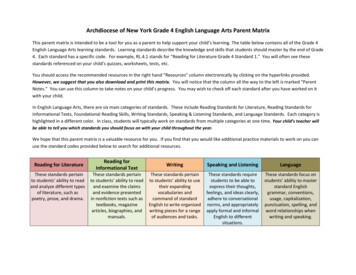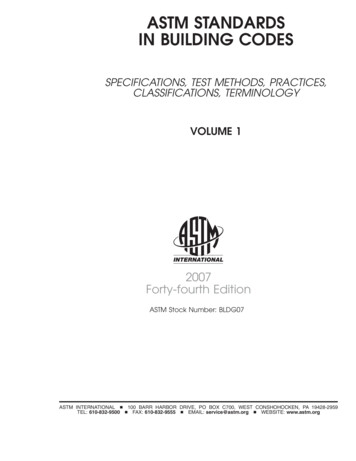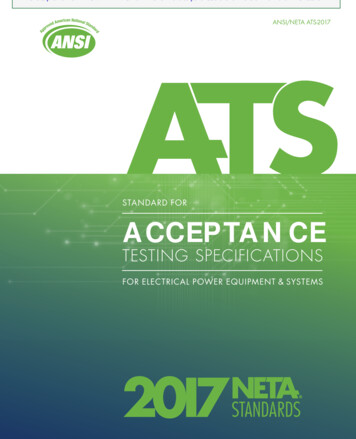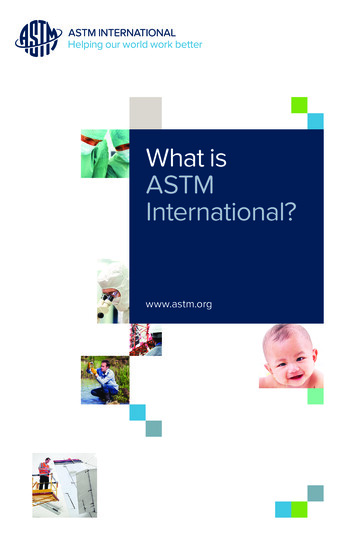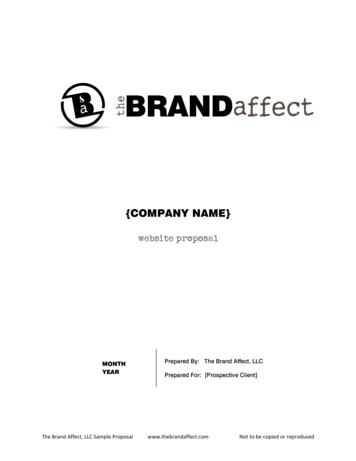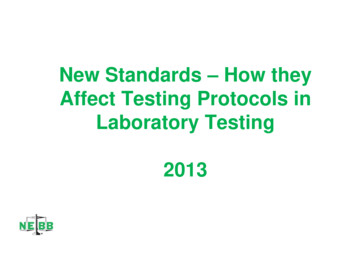
Transcription
New Standards – How theyAffect Testing Protocols inLaboratory Testing2013
The order of the LawThere is a legal pecking order that dictates what Codes andStandards should be use for worker protection.#1 LAWSA OSHA FEDERALB OSHA STATEC EPA FEDERALD EPA STATEE NRC FEDERALFADA FEDERAL2
The order of the LawContinued#2 CODESA NFPA (FIRE)B BUILDING (IBC, BOCA, UBC, ETC.)C ASME, JIC, NEC, ETC.3
The order of the LawContinued#3 ANSI NATIONAL CONFORMANCE STANDARDSA NSI/ASHRAE 110 FUME HOOD PEFORMANCEBANSI/ AIHA Z9.5CANSI/ASHRAE III 1988 TESTING AND BALANCINGD ANSI/ASHRAE 62 - SUPPLY AIR QUALITYE ACGIH- INDUSTRIAL VENTILATION HANDBOOK4
The order of the LawContinued#4STANDARDS, GUIDELINES, AND RECOMMENDEDPRACTICESA. SEFA -1 (FUME HOOD TRADE ORGANIZATION)B. PRUDENT PRACTICES IN LABORATORIES5
OVERVIEWMany regulatory changes have been broughtinto the laboratory environmentThe basis for the OSHA 29 CFR Part 1910 is toencourage joint labor management efforts toreduce injuries and diseases arising out ofemployment in laboratory environment as wellas developing innovative methods, techniques,and approaches for dealing with occupationalsafety and health problems.6
What types of hazardous chemicalsare present in laboratories?Hazardous chemicals present physical or healththreats to workers in clinical, industrial, and academiclaboratories.They include carcinogens, toxins, irritants, corrosives,sensitizers, hepatotoxins, nephrotoxins, neurotoxinsas well as agents that act on the hematopoieticsystems or damage the lungs, skin, eyes, or mucousmembranes.OSHA currently has rules that limit exposures toapproximately 400 substances.7
The New StandardThe new OSHA standard differs from manyOSHA health standards in that it does notestablish new exposure limits but setsother performance provisions designed toprotect laboratory workers from potentialhazards in their work environment.8
OSHA StandardPermits a greater degree offlexibility in laboratories fordeveloping and implementingemployee safety and healthprograms.9
Expected Benefits Increased worker awareness ofpotential risks Improved work practices Existing PPEEngineering controls fume hoods vacuum systems glove boxeswhich limit chemical exposure and areconsidered conventional technology thatcan be found in nearly all laboratories.10
“Laboratory use”?Performing chemical procedures using smallquantities of hazardous chemicals on alaboratory scale and not as part of aproduction process in an environment whereprotectivelaboratorypracticesandequipment are in common use.11
ANSI Z9.5 – 2012Function of aLaboratory?Laboratories conduct teaching, research,quality control, and related activities andshould satisfy several general objectives, inaddition to being suited for the intended usethey should be:12
ANSI Z9.5 – 2012 Energy efficient without sacrificing safety,compliance, or space condition requirements Safe places to work, comply with environmental,health, and safety regulations, and Meet any necessary criteria for the occupants andtechnology involved in terms of control oftemperature, humidity, and air quality.13
Employers are required to have achemical hygiene planIf your laboratory employees use hazardouschemicals, you must develop and implement awritten chemical hygiene plan to protect them. Inaddition to appropriate safety and healthprocedures and hygiene practices for hazardouschemicals in laboratories, the plan mustinclude the following:14
Chemical Hygiene Plan Criteria for reducing employee exposure to hazardouschemicals; Use of personal protective equipment; Requirements that ensure fume hoods and otherprotective equipment are functioning properly;(ASHRAE – 110) Provisions for employee training; Circumstances requiring employer approval of certainlaboratory operations, procedures, or activities beforeimplementation;15
Laboratory Ventilation Management Plan(LVMP)Management shall establish a LaboratoryVentilation Management Plan (LVMP) toensure proper selection, operation, use,and maintenance of laboratory ventilationequipment.16
ANSI Z9.5 – 2012LVMPEnsure proper operation of the lab ventilationsystems, help protect laboratory personnelworking with potentially hazardous airbornematerials, provide satisfactory environmentalair quality and maintain efficient operation ofthe laboratory ventilation systems.17
ANSI Z9.5 – 2012LVMPProvides the framework forkeeping the systems operating tosatisfy the primary functionalrequirements of buildingpersonnel.18
How does this affect NEBB?The US Congress has put some teeth into the regulations– providing for a monitoring process to ensure the healthof the workers through continuous monitoring.The employer is required to measure an employee'sexposure to any substance regulated by a standardwhich requires monitoring if there is reason to believethat exposure levels for that substance routinely exceedthe action level (or in the absence of an action level, thePEL).19
How must employers monitoremployee exposures?Monitoring used to be terminated whenemployee exposures were below the actionlevel but now the burden of proof lies withthe employer that all devices have beenproperly tested and commissioned withperiodic verification of performance.Monitoring and healthcare can continuefor an employee’s entire life.20
Exposure Control DevicesThere are numerous exposure controldevices including: Laboratory Fume Hoods Biological Safety Cabinets (BSC) Glove boxes Local exhaust hoods, and other ventilatedenclosures21
Exposure Control DevicesThere are numerous exposure controldevices including: Laboratory Fume Hoods Biological Safety Cabinets (BSC) Glove boxes Local exhaust hoods, and other ventilatedenclosures22
OSHAOSHA requires that, employers are responsiblefor ensuring that exposure control devices arefunctioning properly and implementing feasiblecontrol measures to reduce employeeexposures if the exposures exceed the PELs.The problem is:OSHA does not promulgate specific controldevice testing protocols.23
OSHABut, if an employer discovers through theirhazard assessment efforts or employeefeedback, that exposure control devicesare not effectively reducing employeeexposures, it is the employer'sresponsibility to adjust controls or replaceengineering controls as necessary.24
Performance EvaluationThe performance of an exposure controldevice is ultimately determined by itsability to control exposure to withinapplicable standards or other safe limits.25
Who evaluates the performance?The LVMP should provide guidelines andspecifications for implementation andproper operations of the completelaboratory environment.26
Beginning of the LVMP Commissioning to verify proper performance priorto occupancy and use of the laboratory hoods Training programs for ensuring proper use,testing and maintenance of the laboratory hoods Design of laboratory ventilation systems Maintenance procedures for providing anddocumenting reliable operation27
LVMP Periodic confirmation that the ventilation systemis used properly Proper selection of appropriate laboratory hoods Specification of monitors to continuously verifyproper operation of the laboratory hoods, and standardprocedures for routine testing.28
NEBB’s InvolvementNEBB through it’s various disciplines can provide theexpertise to the Laboratory Owners, Managers,Engineers, etc. for the development and requiredconfirmation of a Laboratory Ventilation ManagementPlan (LVMP) to meet the continuously changing researchenvironment.Guidance by the knowledgeable Certified Professionalsin the diverse yet integrated NEBB programs will providea safer environment while enhancing the reputation andintegrity of the organization.29
TrainingEnhancement of the training opportunities in all thedisciplines to meet the requirements in the Laboratoryenvironment.Provide increased awareness to the biological andchemical dangers associated with the research industry.Verify that all disciplines have a safety plan and follow it!30
Meeting the Need!Educating our clients– What do they need for a viable LVMP Development of the plan– How to start Implementation of the proper testing– Follow through Continuous monitoring31
ConsequencesUnder the laboratory standard, routine exposureabove an action level will require the same exposuremonitoring and medical surveillance provisions as inthe relevant substance specific standard.In plain old English – there is a liability to monitorand provide necessary medical and financialassistance until?32
What does it all mean?The OSHA standard added the term hazardous chemicalto further clarify the fact that the laboratory employer mustoffer protection to all laboratory workers in all situations.It also defines employees not as not just laboratoryworkers but also personnel that through their course ofemployment are required to enter the lab where potentialexposures may occur; such as maintenance, custodial, orcontractors. Even personnel with advanced degrees;e.g., chemists and researchers may not possess theproper training in safety aspects associated with chemicalexposures.33
Monitoring or testing?The changes in OSHA Laboratory Standard affects otherregulations and standards; such as AIHA/ANSI Z9.5 2012 which in turn has adopted these changes as well asUS Congress input.Without proper determination of performance ofexposure control devices and continued monitoringto ensure proper and adequate performance, allparties are exposing themselves to greater liabilitynot just to an exposed worker but everyone in thatenvironment.The liability for health care monitoring is not assigned tojust the owner/employer but can include all parties frommanufacturer, installer, TAB contractor, etc.34
NEBB’s InvolvementWhile this is only one area of involvement forNEBB, the continued research anddevelopment as well as healthcare industriesare growing rapidly requiring the expertiseavailable from our Certified Professionals.Besides providing a safer environment, weare able to promote the competency of ourorganization and provide a viable opportunityfor the NEBB firms and CP’s.35
Questions orcomments?Copyright 2013 NEBB. All rights reserved.36
ANSI Z9.5 – 2012 Energy efficient without sacrificing safety, compliance, or space condition requirements Safe places to work, comply with environmental, health, and safety regulations, and Meet any necessary criteria for the occupants and technology involved in terms of control of temperature, humidity, and air quality. 13
